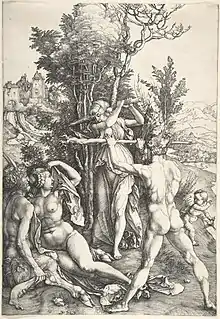Hercules at the crossroads
Hercules at the crossroads, also known as the Choice of Hercules and the Judgement of Hercules, is an ancient Greek parable attributed to Prodicus and known from Xenophon. It concerns the young Heracles/Hercules who is offered a choice between Vice and Virtue—a life of pleasure or one of hardship and honour. In the early modern period it became a popular motif in Western art.

History
Classical period
The parable stems from the Classical era of ancient Greece and is reported by Xenophon in Memorabilia 2.1.21–34. In Xenophon's text, Socrates tells how the young Heracles, as the hero contemplates his future, is visited by the female personifications of Vice and Virtue (Ancient Greek: Κακία and Ἀρετή; Kakía and Areté). They offer him a choice between a pleasant and easy life or a severe but glorious life, and present their respective arguments. Xenophon credits the invention of the parable to Prodicus. He cites a precursor in Hesiod's Works and Days, which also contrasts the paths of vice and virtue.[2]
The motif then appears in a number of works by ancient Greek and Roman writers. Aristophanes used it in a humorous way in the comedy The Birds, where Heracles has to choose between kingship and a tasty meal and almost chooses the meal. In book 15 of the epic poem Punica by Silius Italicus, the military commander Scipio Africanus appears in a situation modeled on the choice of Heracles.[2] The literary device of a contest in dialogue appears within many different genres throughout the literature of ancient Greece. It is related to the controversy stories in the Gospel of Matthew.[3]
Early modern period
In the Renaissance the story of Hercules at the crossroads became popular again, and it remained so in Baroque and Neoclassical culture. It became a part of the broader motif of psychomachia: the battle of spirits or soul war.[4] Petrarch used it in De vita solitaria (1346) and established it in the mainstream of Renaissance humanism as a figure of the choice between a contemplative life and an active life. Petrarch had read Cicero's summary of the story in De Officiis. Like Xenophon, Cicero stresses the hero's solitude as he deliberates with himself. Four decades after Petrarch's adaptation, Coluccio Salutati reintroduced the original moral choice between Virtus and Voluptas, using Cicero's Latin words.[2]
Famous examples from the visual arts include Albrecht Dürer's print Hercules at the Crossroads (1498), Paolo Veronese's Allegory of Virtue and Vice (1565), Annibale Carracci's The Choice of Hercules (1596), Gerard de Lairesse's Hercules between Virtue and Vice (1685) and Mariano Salvador Maella's mural in the Royal Palace of Madrid, Hercules between Virtue and Vice (1765–66).[4] The story appears in musical compositions such as Laßt uns sorgen, laßt uns wachen by Johann Sebastian Bach and The Choice of Hercules by George Frideric Handel.[4]
This tale is retold and forms a central part of the George O’Conners book, Hera: The Goddess and her Glory. There, its shown that Heracles’s stepmother, Hera, is, among other things, responsible for his having to complete his arduous Labors and how more often than not she made them even more difficult than they otherwise would have been. Heracles comes to hate her for the sufferings he has to endure but his fellow hero Jason, to whom Hera is a patron, says that yes she has made his life difficult but by overcoming these difficulties he has won everlasting fame. Towards the end, Heracles (whose name means “Hera’s glory”) learns that it was she who disguised herself as Virtue to offer him, via a life of sacrifice, the chance to be remembered forever.
At the end, when Heracles ascends to godhood, it is Virtue/Hera who with a smirk welcomes to Olympus “her glory.” [5]
See also
References
- "Hercules at the crossroads". Collection online. British Museum.
- Tucker, George Hugo (2003). Homo Viator: Itineraries of Exile, Displacement and Writing in Renaissance Europe. Librairie Droz. pp. 81–84. ISBN 978-2-600-00857-0.
- Repschinski, Boris (2000). The Controversy Stories in the Gospel of Matthew. Vandenhoeck & Ruprecht. pp. 286–290. ISBN 3-525-53873-1.
- Tucker, Shawn R. (2015). The Virtues and Vices in the Arts: A Sourcebook. Wipf and Stock Publishers. pp. 179–181. ISBN 978-1-62564-718-4.
- O'Conner, George, Hera: The Goddess and her Glory. First Second Publishing, 2011
Further reading
- Erwin Panofsky. Hercules am Scheidewege und andere antike Bildstoffe in der neueren Kunst. (Studien der Bibliothek Warburg 18). Teubner, Leipzig/ Berlin 1930.
External links
 The full text of Xenophon's Memorabilia at Wikisource (Greek text only)
The full text of Xenophon's Memorabilia at Wikisource (Greek text only)